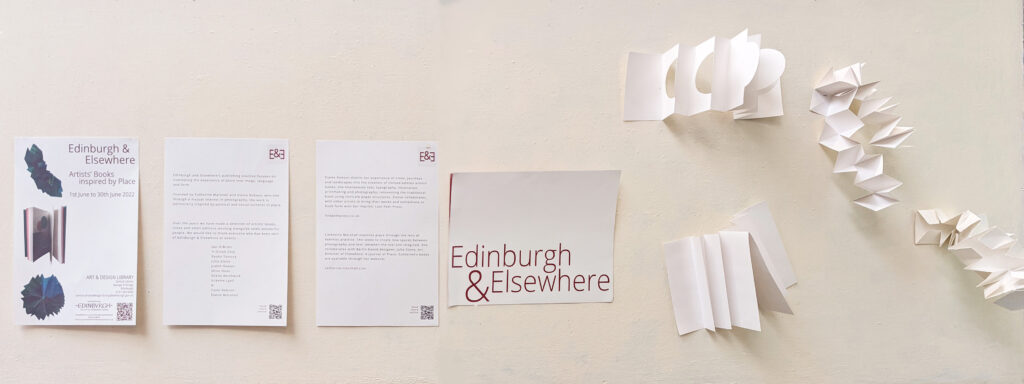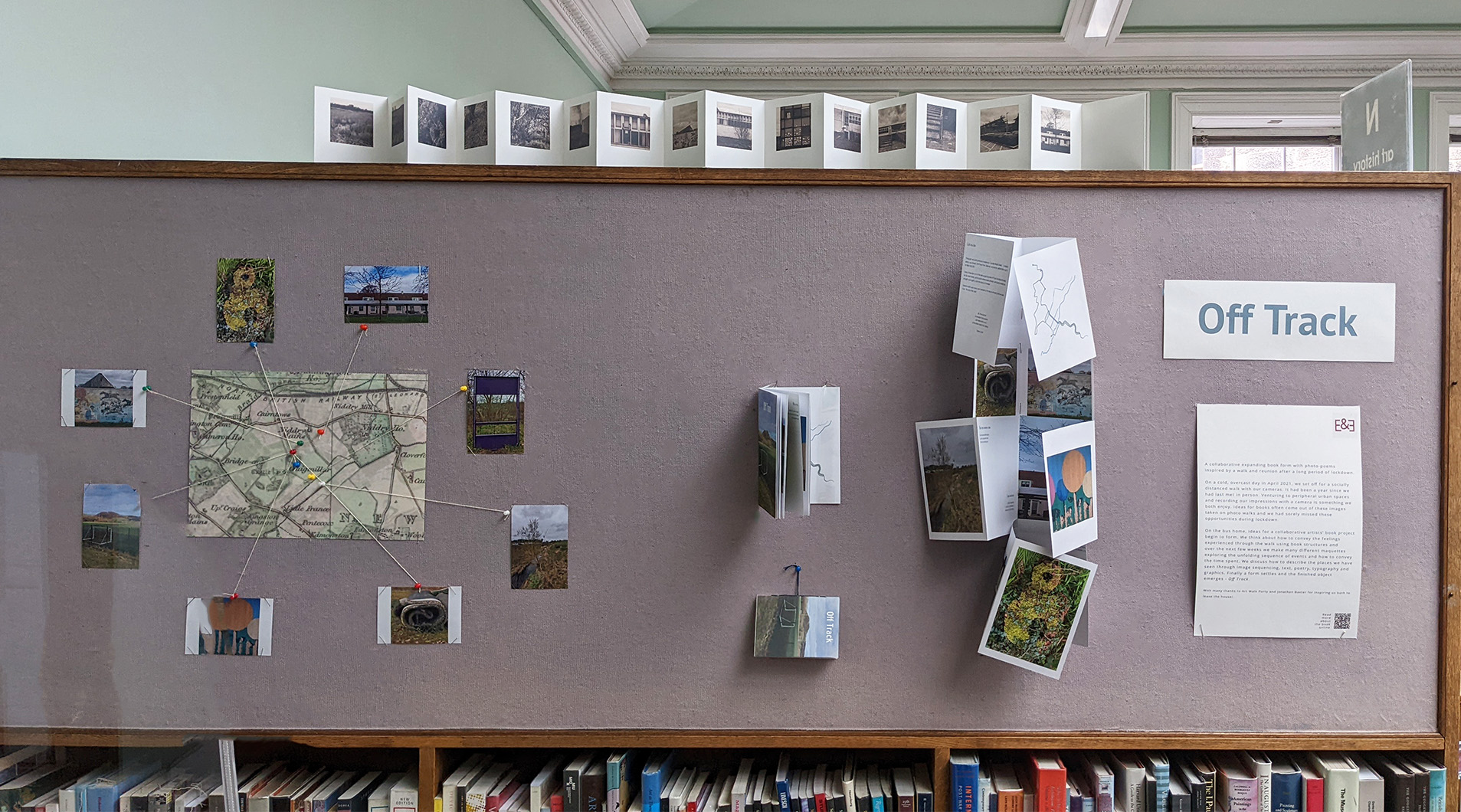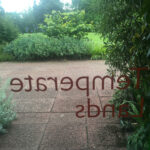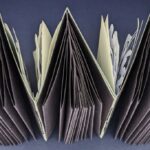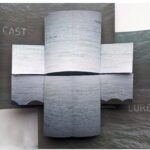A retrospective exhibition of books produced by Catherine Marshall (Compartmentsee Press) and Elaine Robson (Lost Path Press) over the last 7 years.
Edinburgh and Elsewhere’s publishing practice focuses on translating the experience of place into image, language and form. Founded by Catherine Marshall and Elaine Robson, who met through a mutual interest in photography, the work is particularly inspired by political and social currents of place.
Here is a brief overview of the installation for those not able to visit in person.
Off Track
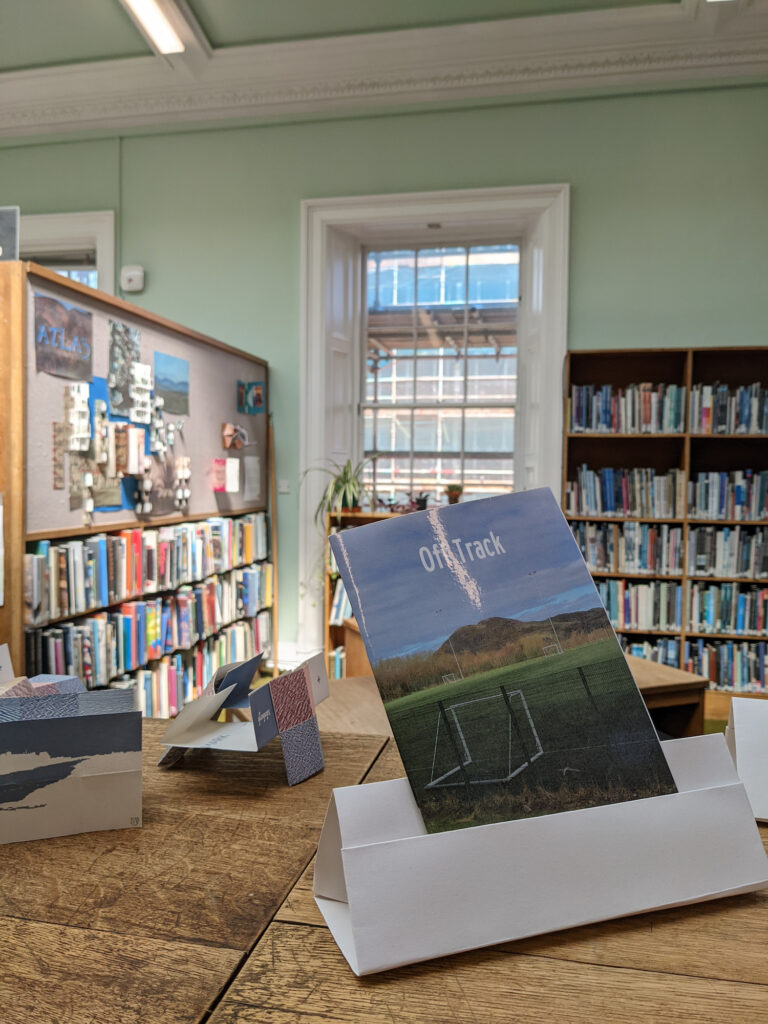
Little France, Edinburgh. – Elaine and Catherine
A collaborative expanding book form with photo-poems inspired by a walk and reunion after a long period of lockdown.
On a cold, overcast day in April 2021, we set off for a socially distanced walk with our cameras. It had been a year since we had last met in person. Venturing to peripheral urban spaces and recording our impressions with a camera is something we both enjoy. Ideas for books often come out of these images taken on photo walks and we had sorely missed these opportunities during lockdown.
On the bus home, ideas for a collaborative artists’ book project begin to form. We think about how to convey the feelings experienced through the walk using book structures and over the next few weeks we make many different maquettes exploring the unfolding sequence of events and how to convey the time spent. We discuss how to describe the places we have seen through image sequencing, text, poetry, typography and graphics. Finally a form settles and the finished object emerges – Off Track.
With many thanks to Art Walk Porty and Jonathan Baxter.
The Future Is Trending
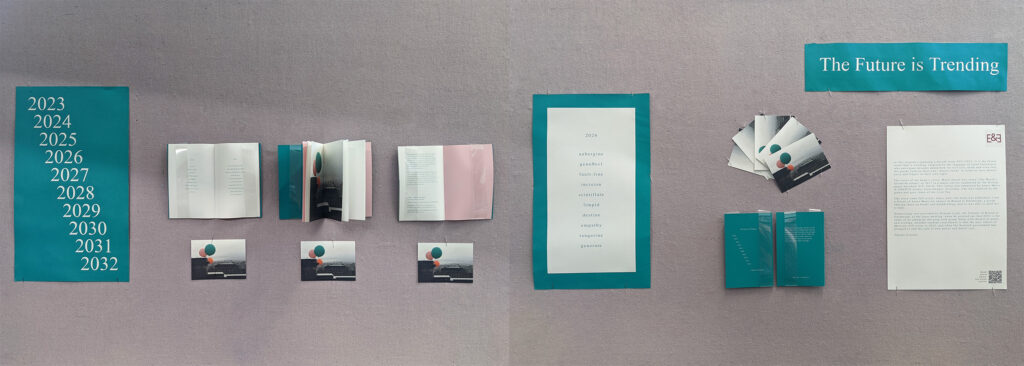
The Future. – Catherine
In this sequence spanning a decade from 2023-2032, it is the future itself that is trending. Inspired by the language of trend forecasters who anticipate decades ahead how we will live, think and even feel, the poems fashion their own ‘macro trends’ in terms at once absurd, eerie and fragile in their own logic.
The book’s cover colour, – Marrs Green – was voted ‘The World’s favourite colour’ in 2017 in a major survey conducted by the British paper merchant G.F. Smith. The colour was submitted by Annie Marrs, A UNESCO worker from Dundee, Scotland, who was inspired by the green and grey tones of the river Tay.
“The story came full circle, when, after the book was published, I met a friend of Annie Marrs by chance at Bound in Edinburgh, a group sharing ideas on books and bookbinding, and so was able to send her a copy.”
“Numerology was provided by Graeme Lyall, the founder of Bound in Edinburgh, at the same meeting, when he pointed out that 2032 is the name of an album by the prog rock group Gong with themes of peace and ecology. Another random coincidence is that the next transit of Mercury will occur in 2032, and when the Scottish government has pledged to end the sale of new petrol and diesel cars.”
The Temperate House
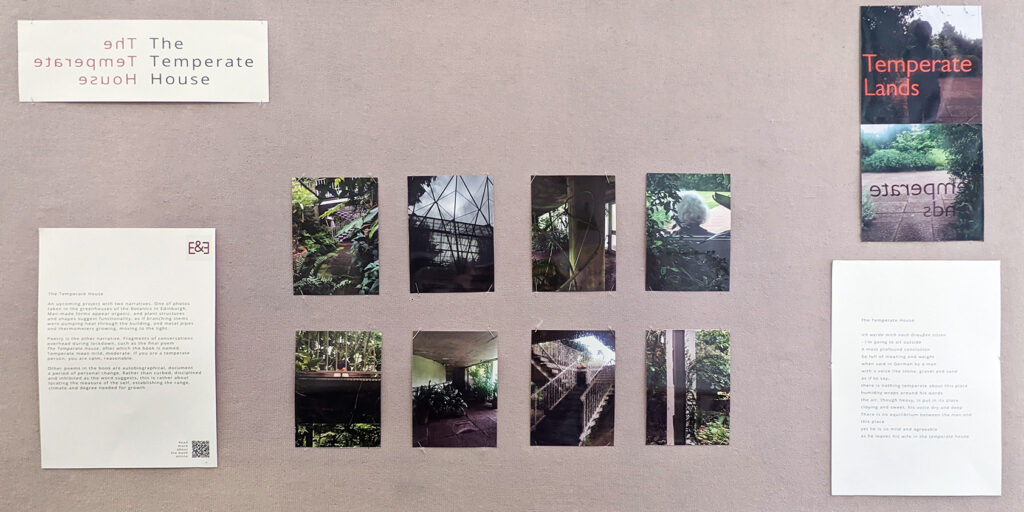
Royal Botanical Gardens, Edinburgh. – Catherine
An upcoming project with two narratives. One of photos taken in the greenhouses of the Botanics in Edinburgh. Man-made forms appear organic, and plant structures and shapes suggest functionality, as if branching stems were pumping heat through the building, and metal pipes and thermometers growing, moving to the light.
Poetry is the other narrative. Fragments of conversations overhead during lockdown, such as the final poem The Temperate House, after which the book is named. Temperate mean mild, moderate. If you are a temperate person, you are calm, reasonable.
Other poems in the book are autobiographical, document a period of personal change. Rather than curbed, disciplined and inhibited as the word suggests, this is rather about locating the measure of the self, establishing the range, climate and degree needed for growth.
To the Peninsula, My Friends
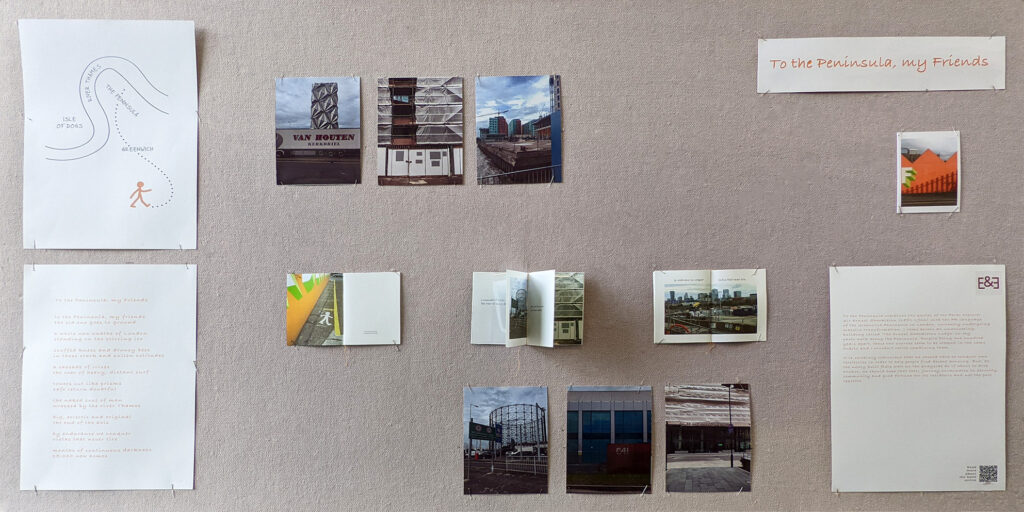
Greenwich, London – Catherine
To the Peninsula combines the quotes of the Polar explorer Sir Ernest Shackleton (1871-1922) with the PR language of the Greenwich Peninsula in London, currently undergoing massive transformation.
“I came across an unassuming building called ‘The Ernest Shackleton Lodge’ on my photo walk along the Peninsula. Despite being one hundred years apart, these two sources seem to be steeped in the same hubris and I couldn’t resist combining them.”
“It is certainly ridiculous that we should have to conquer new territories in order to help people find decent housing. But, as the newly built flats wait on the quayside as if about to drop anchor, we should hope that their journey culminates in security, community and good fortune for its residents and not the pole opposite.”
Fleetway

Cammo Estate, Edinburgh. – Catherine
A broken-down house, a photographic film, an antiquated camera and an abandoned carpet sweeper are the unlikely protagonists of this story inspired by a failed roll of film and set at the Cammo estate in Edinburgh. As light leaked into the camera, wilderness and happenstance that had taken over the past grandeur of the estate breathed life into inanimate objects, to question the medium of photography itself.
Fleetway is an artists’ book published in a small edition of 100, 2017.
Atlas
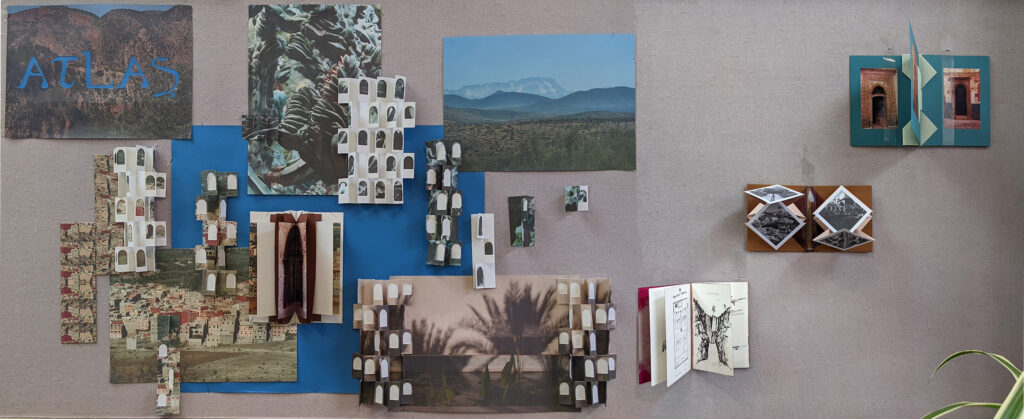
Morocco, early 2020, another world. – Elaine
Arriving into Marrakech as the sun sets over the Atlantic in the west and the land turns from sand to rust to indigo ink. The mountains are steady in the background, waiting , a barrier to travelers, a view to ponder, a guard on the horizon.
The mountains have provided irrigation for a thousand years to the secret gardens of the city. Cool water, green courtyards, fruiting trees, rose coloured cubes – a simple structure stacked to form everything from modest villages to grand estates with walls to protect crops and privacy.
This series of cut and folded gallery books, crown bindings, coptic journal, map folds and structures inspired by Van Viliet/Steiner from their book Woven and Interlocking Structures.
North
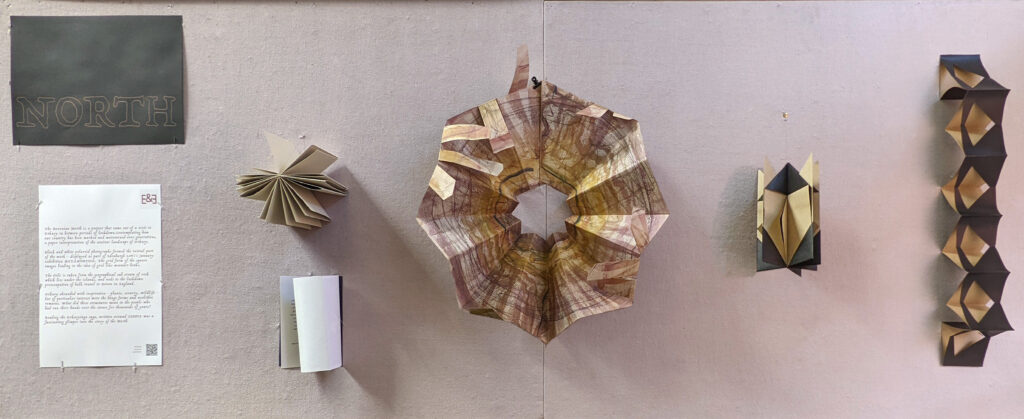
Orkney, Scotland. – Elaine
The Devonian North is a project that came out of a visit to Orkney in between periods of lockdown. Contemplating how our country has been marked and maintained over generations, a paper interpretation of the ancient landscape of Orkney.
Black and white polaroid photographs formed the initial part of the work – displayed as part of Edinburgh LoFi’s January exhibition METAMORPHIC. The grid form of the square images leading to the idea of grid like meander books. The title is taken from the geographical sub strata of rock which lies under the islands, and nods to the lockdown preoccupation of bulk travel to Devon in England.
Orkney abounded with inspiration – plants, scenery, wildlife – but of particular interest were the henge forms and neolithic remains. What did these structures mean to the people who had ran their hands over the stones for thousands of years? Numerous book forms were made referencing the manmade traces on the landscape.
Reading the Orkneyinga saga, written around 1200CE was a fascinating glimpse into the story of the North and it was interesting to match verse with image.
Ume
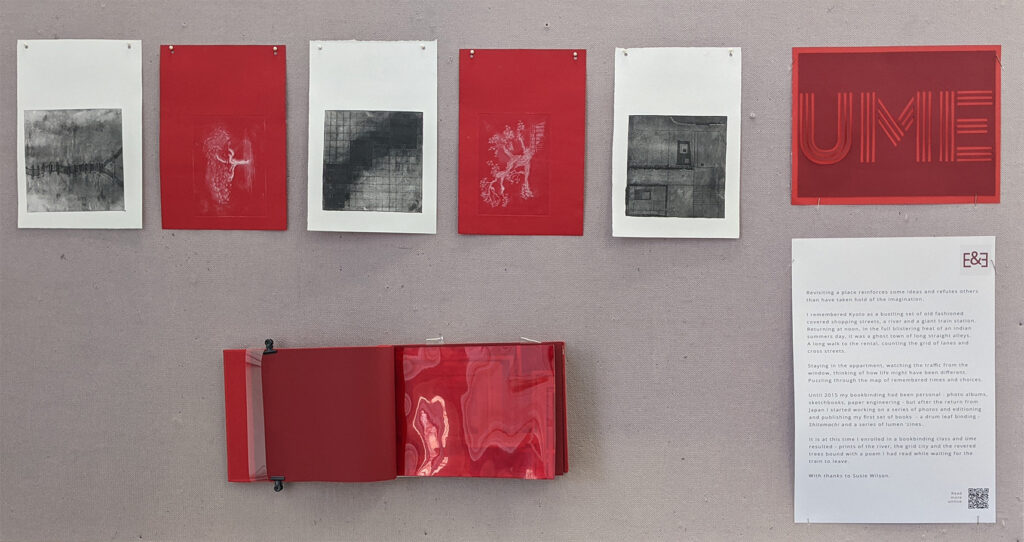
Kyoto, Japan. – Elaine
Prints, paintings, collagraphs and etchings from the deconstructed post bound book.
Revisiting a place reinforces some ideas and refutes others than have taken hold of the imagination in the interim.
“I remembered Kyoto as a bustling set of old fashioned covered shopping streets, a river and a giant train station. Returning at noon, in the full blistering heat of an indian summers day, it was a ghost town of long straight alleys. A long walk to the rental, counting the grid of lanes and cross streets.”
“Staying in the appartment, watching the traffic from the window, thinking of how life might have been different. Puzzling through the map of remembered times and choices.”
“Until 2015 my bookbinding had been personal – photo albums, sketchbooks, paper engineering – but after the return from Japan I started working on a series of photos and editioning and publishing my first set of books – a drum leaf binding – Shitamachi (Under City) and a series of lumen ‘zines.”
“It is at this time I enrolled in a bookbinding class and Ume resulted – prints of the river, the grid city and the revered trees bound with a poem I had read while waiting for the train to leave Kyoto.”
Mavisbank
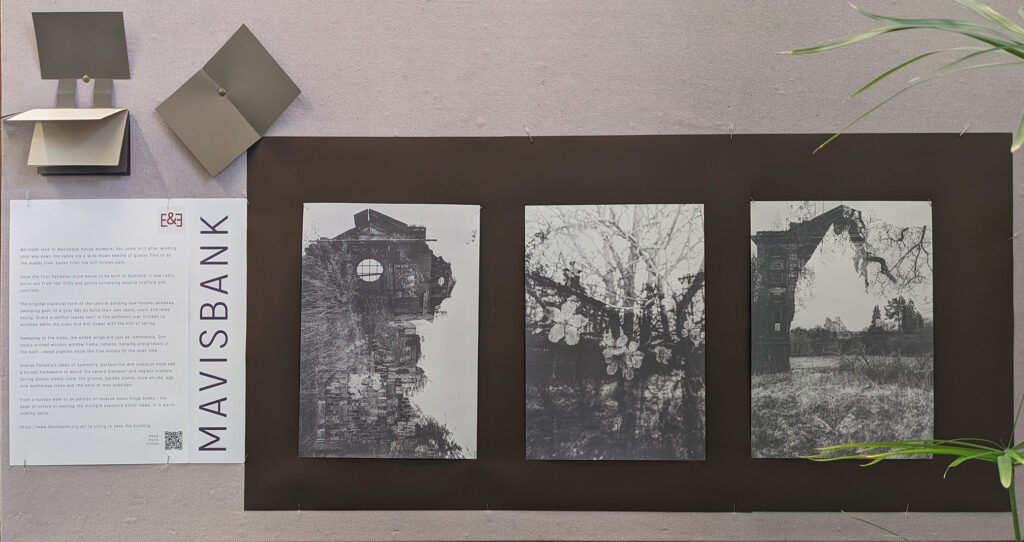
Near Lasswade, Midlothian. – Elaine
No roads lead to Mavisbank House anymore. You come to it after winding your way down the valley via a wide mown swathe of grassy field or by the muddy river banks from the mill stream path.
Once the first Palladian style house to be built in Scotland, it now rests, burnt out from the 1970s and gently collapsing despite scaffold and concrete.
The original classical form of the central building is now home to jackdaws, swooping past on a grey day to court, build their own nests, and raise young. Grand acanthus leaves swirl in the pediment over bricked up windows while the trees bud and flower with the hint of spring.
Sweeping to the sides, the added wings are just as ramshackle. One lonely arched wooden window frame remains, hanging precariously in the sash – wood pigeons enjoy the free access by the open view.
Andrea Palladio’s ideas of symmetry, perspective and classical style add a formal framework to which the severe disrepair and neglect organically crumble. Spring shoots slowly cover the ground. Garden plants, once shrubs, age into monterous trees and the hand of man subsides.
From a Sunday walk to an edition of reverse piano hinge books – the page structure bisecting the multiple exposure photo views. It is worth looking twice.

https://www.mavisbank.org.uk/ is trying to save the building.
Carousel
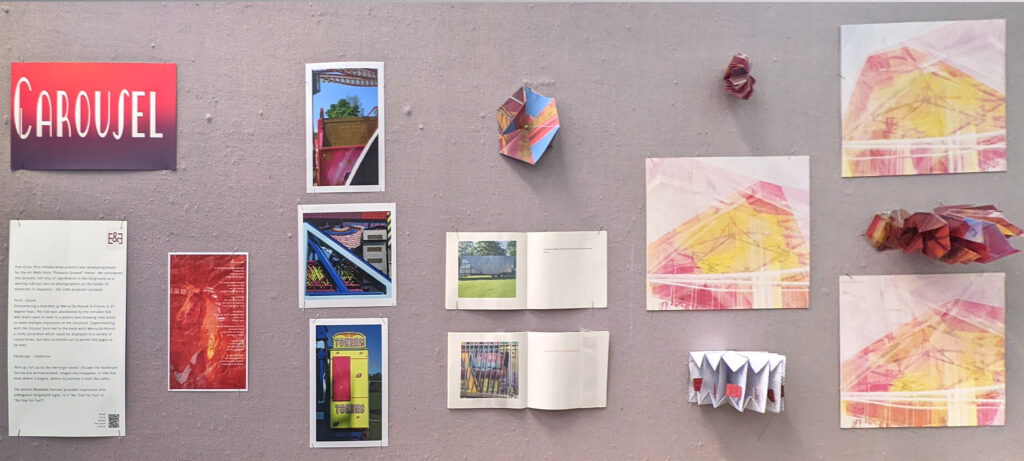
Developing books for the Art Walk Porty “Pleasure Ground” theme led our collective to consider the carousel, not only of significance in the fairground as a swirling ride but also to photographers as the holder of memories in sequence – the slide projector carousel.
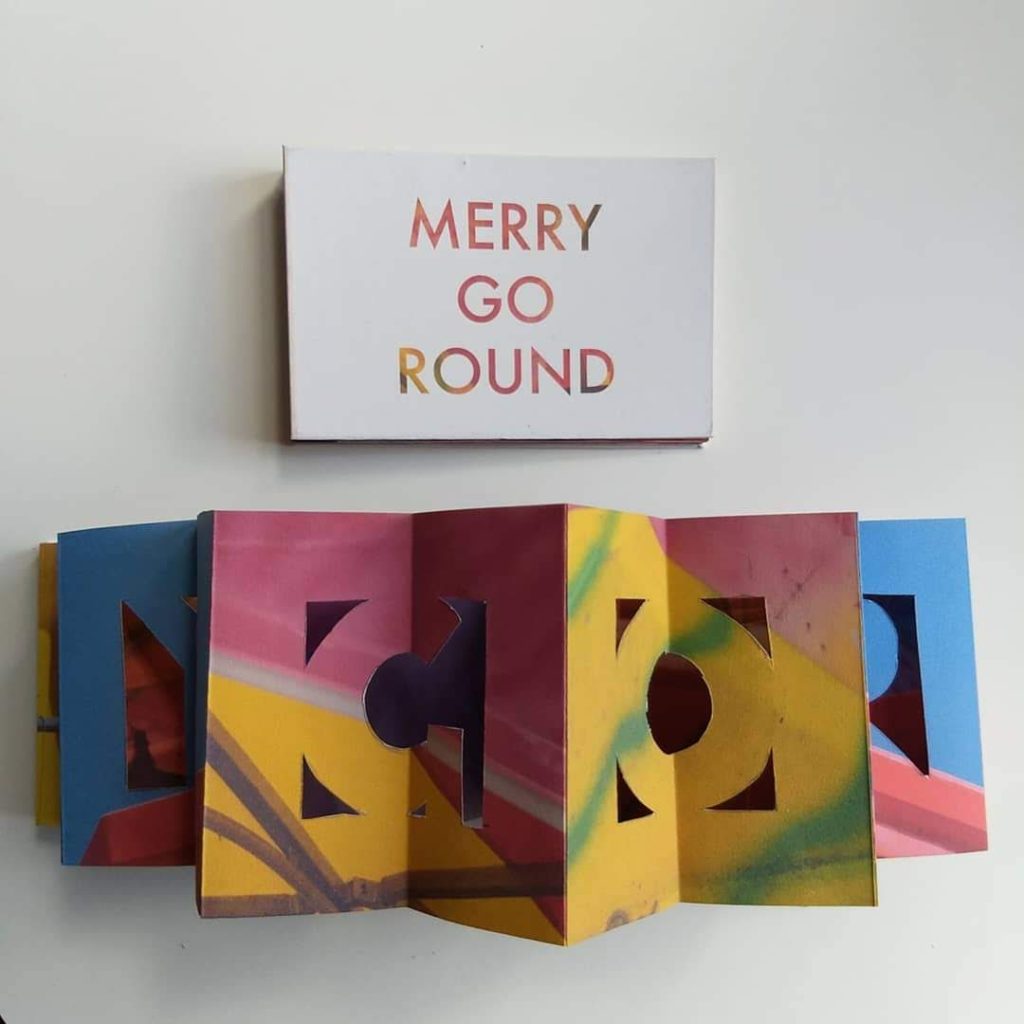
Paris – Elaine
Encountering a boarded up Merry-Go-Round while visiting France during a 37 degree heatwave, the ride was abandoned by the sensible folk who didn’t want to melt in a plastic tent. This time alone allowed a period of undisturbed appraisal and for multiple exposures of the structure to be made. Experimenting with the circular form led to the main work – Merry-Go-Round – a slinky hand-cut book which could be displayed in a variety of round forms, but also stretched out to permit the pages to be seen. (Edition of 5 with 1 artists proof).
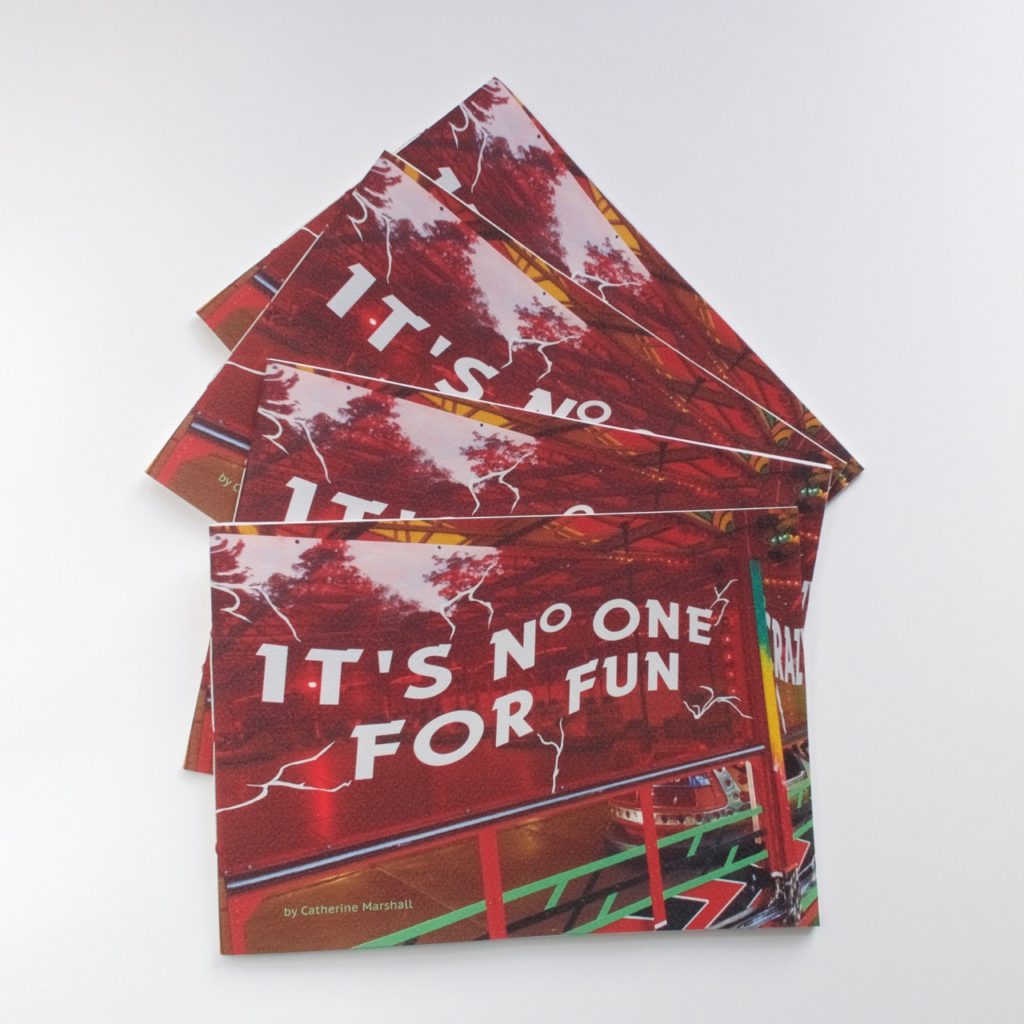
Edinburgh – Catherine
‘Roll up, roll up to the merry-go-round ! Escape the humdrum ! Stories are written/erased, images blur/reappear. A ride that ends where it begins, where no journey is ever the same…’
The annual Meadows Festival provided inspiration with ambiguous fairground signs. Is it “No. One for Fun” or “No One for Fun”?
“The merry-go-round is a favourite fairground ride for many, offering the chance to escape from the humdrum, albeit momentarily, into a different world. It is a place where you can travel, but without going anywhere. The ride just ends where it starts. But many things can happen riding the merry-go-round. Memories can fade away or be recollected, stories can be written or conversely erased, images can blur, fade and reappear all within a matter of moments. The ride is repeated but different details appear, other moments matter, new thoughts occur”
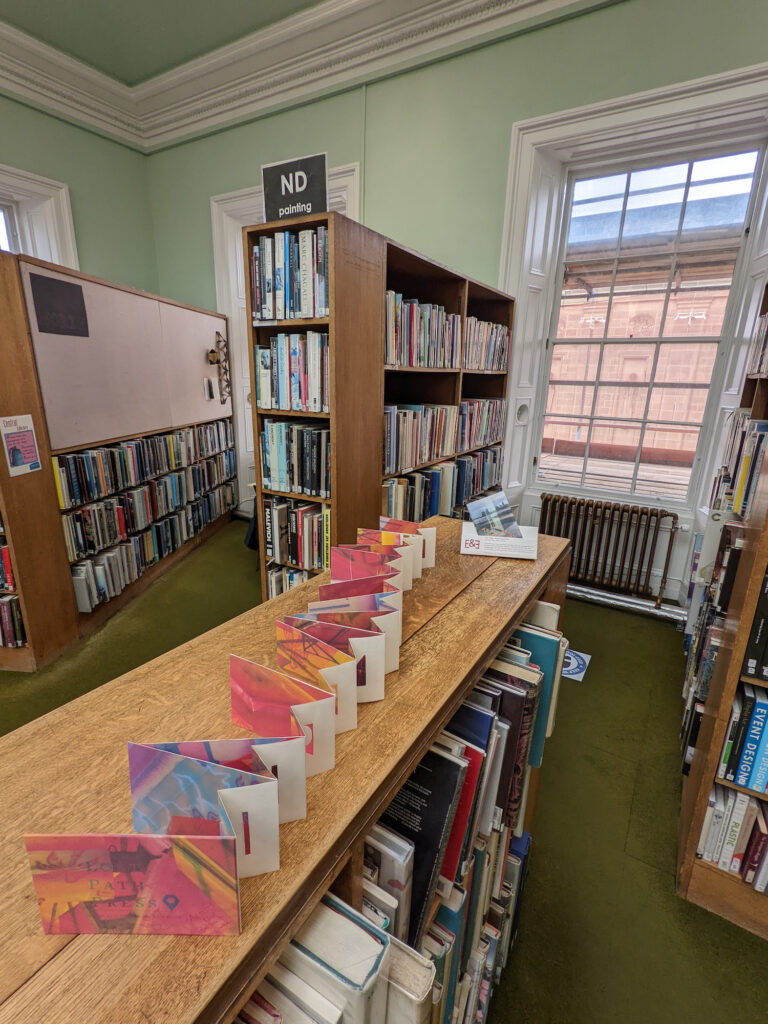
Thanks!
Over the years we have made a selection of artists’ books, ‘zines and small editions working alongside some wonderful people. We would like to thank everyone who has been part of Edinburgh & Elsewhere at events –
- Carol Robson
- Elaine Marshall
- Ger O’Brien
- Chiu, Yi-Chieh
- Stuart Caie
- Ryoko Tamura
- Julia Stone
- Graeme Lyall
- Susie Wilson
- Jonathan Baxter
- Art Walk Porty
- Judith Rowan
- Olive Dean
- Sheila and Alan Borthwick
- and everyone else who has helped and inspired us over the last 7 years!
